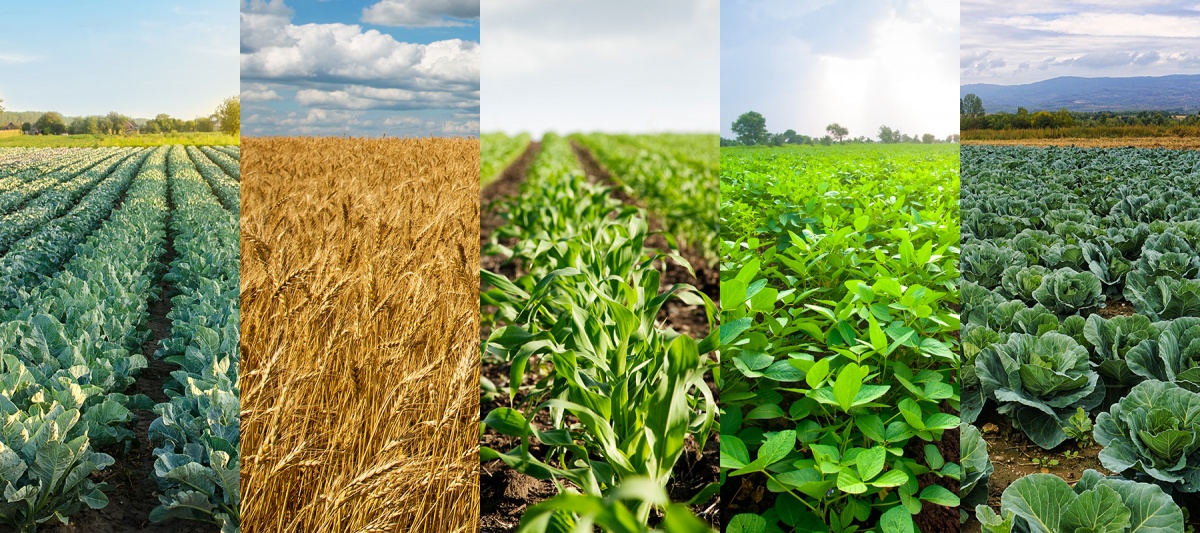What is crop rotation?
Crop rotation refers to the practice of planting different crops in the same plot over different time periods. For example, planting broccoli one season, winter wheat the next season and sweet corn the next. Using a variety of crops can provide different advantages, such as adding nitrogen to the soil and reducing the need for fertilizer, offering natural weed suppression and disease prevention, improving water quality or reducing erosion, and boosting the organic matter in the soil.
A simple crop rotation might involve planting just two or three crops successively...More complex crop rotations often involve more than three and can include as many as 10-12 crops, with each having different benefits.
A simple crop rotation might involve planting just two or three crops successively, such as a corn crop followed by a soybean crop, which is the most common rotation in the Midwest. More complex crop rotations often involve more than three and can include as many as 10-12 crops, with each crop offering different benefits.
When it comes to crop rotations, complexity is key to boosting levels of nitrogen—a soil nutrient that is critical to crop production. However, new research from an international group of scientists—among them NH Agricultural Experiment Station scientist Stuart Grandy, a professor in the natural resources and the environment department at UNH—shows that complex crop rotations can benefit levels of nitrogen even during droughts, when application of nitrogen fertilizers can be less effective.
“When soils become really dry, nutrient uptake shuts down in plants, limiting plant growth and causing those nutrients–following a subsequent heavy rainfall–to eventually leach out of the soil,” said Grandy. “We were interested in whether complex rotations would be able to handle drought conditions better than simple rotations, and if we’d see more continual uptake of nitrogen during a drought.”
Research-informed management practices, aimed at helping food producers remain resilient to adverse growing conditions, are critical as the Granite State is experiencing more and more drought conditions. Since 2016, parts of New Hampshire have experienced “extreme” droughts—resulting in major crop and pasture losses and widespread water shortages or restrictions—for at least 34 weeks. Several of those weeks occurred consecutively, and all of those weeks fell within the years of 2016, 2020 and 2022, according to the U.S. Drought monitoring system maintained by the USDA, NOAA, and the National Drought Mitigation Center at the University of Nebraska.
Grandy, along with researchers from the University of California Berkeley, Oklahoma State University, the University of Hawaii, and the University of Vienna, published their research in Soil Biology and Biochemistry. Their study had both fundamental and applied components, said Grandy. On the fundamental side, they were looking at the areas that soils accumulated – or “pooled” – nitrogen within for use by plants, and which of those areas (for example, in the soil microbes, in decomposing organic matter, or in organic nitrogen pools associated with the mineral particles themselves) did plants tap into for nutrient uptake. Nutrient uptake refers to the ability of plants to pull in nutrients from the soil. On the applied side, they wanted to know which crop rotation patterns most impacted nitrogen pools and how did drought and non-drought conditions affect the ability of plants to access that nitrogen from different soil pools.

What they found in the study was that nitrogen pooled in an area of soil previously believed to offer little nutrient value to plants – the mineral-associated organic matter (MAOM) comprised of small organic molecules, like amino acids, that stick to mineral or clay particles.
“We found that the MAOM does supply nutrients to plants. And we believe that under limited water, that that’s a specific nitrogen pool that plants tap into,” Grandy said. “Additionally, we learned that complex crop rotations are building up nitrogen specifically within that MAOM, making these complex rotations more resilient to water variability.”
Ultimately, what we learned from this study is that the greater the crop diversity, the greater the potential to increase soil nitrogen, and the greater the ability of those plants surviving – or even thriving – during drought conditions.
“So ultimately, what we learned from this study is that the greater the crop diversity, the greater the potential to increase soil nitrogen, and the greater the ability of those plants surviving – or even thriving – during drought conditions.”
This material is based on work supported by the NH Agricultural Experiment Station through joint funding from the USDA National Institute of Food and Agriculture (under Hatch award number 1020144) and the state of New Hampshire. Support for this research was also provided by the National Science Foundation's Long-term Ecological Research Program (DEB 1832042) at the Kellogg Biological Station and by Michigan State University AgBioResearch.
You can read the published article, Crop rotational complexity affects plant-soil nitrogen cycling during water deficit, in Vol. 166 (March 2022) of Soil Biology and Biochemistry.
-
Written By:
Nicholas Gosling '06 | COLSA/NH Agricultural Experiment Station | nicholas.gosling@unh.edu



















































